

|
|
| « Previous | Next » |
Sequoia National Park |
Thursday, 5 June 2003 |
| written by Teresa |
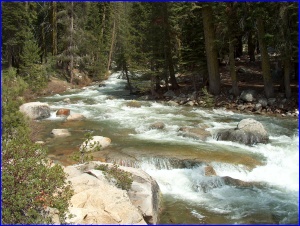 At sixty seven hundred feet, Lodgepole campground in Sequoia National Park is high in the coniferous belt clothing the lower slopes of the Sierra Nevadaís, where the last of the snow still lurks among the trees, transforming into fast flowing streams by the inevitable process of spring melt. The white noise of water rushing headlong down steep valleys has been a constant companion these last weeks, making the silence of the forest deeper and more precious.
At sixty seven hundred feet, Lodgepole campground in Sequoia National Park is high in the coniferous belt clothing the lower slopes of the Sierra Nevadaís, where the last of the snow still lurks among the trees, transforming into fast flowing streams by the inevitable process of spring melt. The white noise of water rushing headlong down steep valleys has been a constant companion these last weeks, making the silence of the forest deeper and more precious.
The Tokopah Falls trail leaves Lodgepole and follows the river upstream traversing numerous tributaries where balance is a crucial factor in successful crossing. Needless to say my socks and boots were quickly sodden but fortunately my hot little feet warmed the cold water up in no time leaving nothing more than a vague sensation of moisture around the toes. In his valiant attempts to keep me on the straight and narrow, or at least on the various stepping stones and logs,
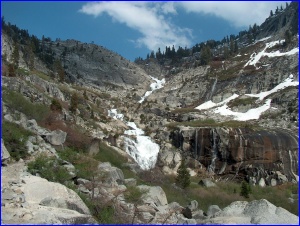 Sterling also acquired a soggy foot although I have my suspicions that he just didnít want to be left out of the fun.
Sterling also acquired a soggy foot although I have my suspicions that he just didnít want to be left out of the fun.
The Falls cascade down a near vertical face of bare rock, part of a natural bowl scooped out of the mountainside. Patches of snow still cling to the slopes and at first glance the whites of snow and frothing water are not immediately distinguishable. What it lacks in width it makes up for in speed and activity as it courses down itís narrow niche, bouncing off boulders, churning and oxygenating as it goes.
In contrast, stillness and quiet permeate the Giant Forest, pollen drifting down through the sunbeams, individual spores caught in the filtered light, settling on every surface in sight. A light yellow dusting catches the spidersí webs and transforms the trail into a facsimile of that well-known brick road. Procreation abounds on the air and tickles the nostrils.
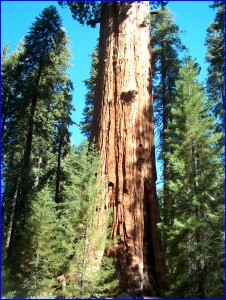 The forest is home to the largest of all the Sequoias, the General Sherman, a monster amongst giants. Growing for between two thousand three hundred and two thousand seven hundred years, it is not the oldest tree but due to its fast rate of growth it is the largest, standing 275 feet high with a maximum base diameter of thirty-six feet and an estimated weight of fourteen hundred tonnes. For me one of the most startling statistics is that itís largest branch has a diameter of nearly seven feet, more than substantial enough to be a big tree in itís own right.
The forest is home to the largest of all the Sequoias, the General Sherman, a monster amongst giants. Growing for between two thousand three hundred and two thousand seven hundred years, it is not the oldest tree but due to its fast rate of growth it is the largest, standing 275 feet high with a maximum base diameter of thirty-six feet and an estimated weight of fourteen hundred tonnes. For me one of the most startling statistics is that itís largest branch has a diameter of nearly seven feet, more than substantial enough to be a big tree in itís own right.
For what itís worth, the Park Service claim that in terms of volume, this is the largest living organism on earth. Other trees may be taller, the Redwoods come to mind, the Banyans of southern Florida may have greater diameters and what look like individual Aspens are actually a single plant covering as much as two hundred acres with numerous up-shoots in the form of distinct looking trees. The largest known Aspen tree, made up of forty seven thousand trunks, is found in the Wasatch Mountains of Utah and has an estimated weight of over six thousand tonnes. Clearly, in terms of weight and volume this challenges the Sequoias claim but in terms of visual impact it lacks the startling effect of the single enormous trunk.
The Giant Forest is quiet and devoid of people early in the morning, the trails meandering between the numerous Sequoias.
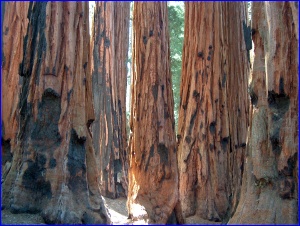 We thought we had already seen big trees but here they are bigger and denser, actually gathering in stands named after The Senate and The House, with The President in splendid isolation. Here is the only mention of Sequoyah, a member of the Cherokee nation, for whom the tree is thought to be named. While he created the Cherokee alphabet, known as ďThe Talking LeavesĒ, we have been unable to track down any association with the trees themselves. The first recording of the Latin name gives no reasoning behind the choice but was coined by a philologist who was a contemporary of Sequoyah.
We thought we had already seen big trees but here they are bigger and denser, actually gathering in stands named after The Senate and The House, with The President in splendid isolation. Here is the only mention of Sequoyah, a member of the Cherokee nation, for whom the tree is thought to be named. While he created the Cherokee alphabet, known as ďThe Talking LeavesĒ, we have been unable to track down any association with the trees themselves. The first recording of the Latin name gives no reasoning behind the choice but was coined by a philologist who was a contemporary of Sequoyah.
Regardless of the facts, figures and speculations, the magic of the place is almost tangible. It is diffiult to convey the sensation of being belittled by these quiet giants without resorting to clichťs. They are magnificent in the true sense of the word and engender a feeling of awe.
The trail up to Muir Grove, another group of Sequoias, leaves from Dorst Creek campground where we moved in order to walk this path. The trail comes up through the forest to emerge on a rounded granite outcrop overlooking a canyon and on the far skyline, the silhouettes of the Sequoia tops. A cooling breeze sweeps across the rock encouraging us to stop for rest and snacks.
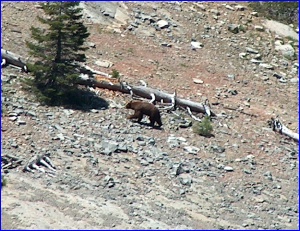 A small shadow on the opposite wall of the canyon moves and through the binoculars proves to be a large Black Bear rummaging on the slopes and investigating various fallen trees. Itís at times like this that we hanker for a telephoto lense as long as your arm but the binos provided clear views of both his markings and behaviour and needless to say we were extremely pleased. Our last sighting of a bear was in 1999 in Glacier, so we were well overdue. Continuing on our way, our sense of awareness heightened, we kept up a steady dialogue so as not to surprise Mr Bear or more importantly, Mrs Bear with cubs.
A small shadow on the opposite wall of the canyon moves and through the binoculars proves to be a large Black Bear rummaging on the slopes and investigating various fallen trees. Itís at times like this that we hanker for a telephoto lense as long as your arm but the binos provided clear views of both his markings and behaviour and needless to say we were extremely pleased. Our last sighting of a bear was in 1999 in Glacier, so we were well overdue. Continuing on our way, our sense of awareness heightened, we kept up a steady dialogue so as not to surprise Mr Bear or more importantly, Mrs Bear with cubs.
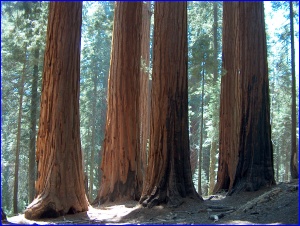 As we came into Muir Grove our attention was temporarily diverted by the huge stand of Sequoias and the beautiful light filtering down to the forest floor. Submersed in reverie, we lost track of the possible presence of our furry friend until a massive cracking of wood resounded close by, raising goose bumps and sending us on our way. Itís one thing to watch at a distance but this was too close for comfort. The thought of those claws ripping apart a dead tree in search of a lunchtime snack was a little too vivid and served as a reminder about who actually lives out here and who is visiting.
As we came into Muir Grove our attention was temporarily diverted by the huge stand of Sequoias and the beautiful light filtering down to the forest floor. Submersed in reverie, we lost track of the possible presence of our furry friend until a massive cracking of wood resounded close by, raising goose bumps and sending us on our way. Itís one thing to watch at a distance but this was too close for comfort. The thought of those claws ripping apart a dead tree in search of a lunchtime snack was a little too vivid and served as a reminder about who actually lives out here and who is visiting.
| « Previous | [ Photos ] | Next » |
Do you know someone who would enjoy this article? Click to e-mail it to them!
| Home | Log | Notes | Maps | Contact | Store |